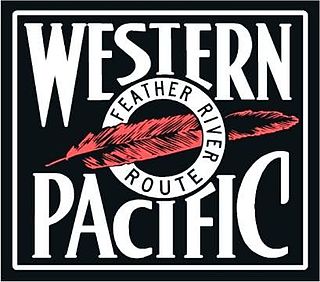Sources
- ↑ "The Northern Railroad". Oakland Tribune. July 5, 1877. p. 3. Retrieved August 7, 2020.
- ↑ Roberson, C.S. "Northern Railway". Sonoma Valley. localwiki. Retrieved 30 January 2019.
The Northern Railway was a non-operating subsidiary of the Southern Pacific Railroad during the 19th century, created primarily as a device to consolidate the management of a number of smaller subsidiary railroads. The initial railroad opened in 1876 from Woodland, California, to Williams; and extended to Willows in 1878, and to Tehama in 1882. In 1877, a line of the Northern Railway was built between Oakland and Martinez. [1] By the time of its 1898 merger into Southern Pacific, it also controlled the Winters and Ukiah Railway, the Woodland, Capay and Clear Lake Railroad, the West Side and Mendocino Railroad, the Vaca Valley and Clear Lake Railroad, the San Joaquin and Sierra Nevada Railroad, the Sacramento and Placerville Railroad, the Shingle Springs and Placerville Railroad, the Santa Rosa and Carquinez Railroad, the Amador Branch Railroad, and the Berkeley Branch Railroad. [2]

The Western Pacific Railroad was a Class I railroad in the United States. It was formed in 1903 as an attempt to break the near-monopoly the Southern Pacific Railroad had on rail service into northern California. WP's Feather River Route directly competed with SP's portion of the Overland Route for rail traffic between Salt Lake City/Ogden, Utah, and Oakland, California, for nearly 80 years. The Western Pacific was one of the original operators of the California Zephyr passenger line.
The Sacramento RiverTrain, formerly the Yolo Shortline Railroad Company, is a common carrier railroad company that runs special excursions from Woodland, California and West Sacramento, California.

The California Pacific Railroad Company was incorporated in 1865 at San Francisco, California as the California Pacific Rail Road Company. It was renamed the California Pacific Railroad Extension Company in the spring of 1869, then renamed the California Pacific Railroad later that same year. Its main railroad from Vallejo to Sacramento was completed six months prior to the May 1869 golden spike ceremony of the Central Pacific/Union Pacific Transcontinental Railway.

The California Northern Railroad is one of several Class III short-line railroad companies owned by Genesee & Wyoming, Inc. It operates over Southern Pacific Railroad (SP) tracks under a long-term lease.
The West Side and Mendocino Railroad is a defunct railroad that operated in California.
The Sacramento Valley Railroad (SVRR) was incorporated on August 4, 1852, the first transit railroad company incorporated in California. Construction did not begin until February 1855 because of financial and right of way issues, and its first train operated on February 22, 1856. Although the oldest working railroad in the state was the Arcata and Mad River Railroad, first operational in December 15, 1854, the Sacramento Valley Railroad was the West's pioneering incorporated railroad, forerunner to the Central Pacific.

The Sacramento Northern Railway was a 183-mile (295 km) electric interurban railway that connected Chico in northern California with Oakland via the California capital, Sacramento. In its operation it ran directly on the streets of Oakland, Sacramento, Yuba City, Chico, and Woodland and ran interurban passenger service until 1941 and freight service into the 1960s.

The Camino, Placerville and Lake Tahoe Railroad was an 8-mile (13 km) Class III short-line railroad operating in the Sierra Nevada in California, east of Sacramento. It was built primarily to haul lumber from the El Dorado National Forest. The standard gauge line ran west 8.05 miles (12.96 km) from a sawmill at Camino to a connection with the Placerville Branch of the Southern Pacific Company at Placerville. Loaded cars of lumber descended a 3.5 percent grade from 3,150 feet (960 m) at Camino to 1,900 feet (580 m) at Placerville.
The Vaca Valley and Clear Lake Railroad was a standard gauge railroad that operated at Vacaville, California in the late 19th century. The Vaca Valley Railroad was incorporated on April 12, 1869 to run a branch from the mainline of the California Pacific Railroad at Elmira to Rumsey.

Martinez station is an Amtrak passenger train station in Martinez, California, United States. Located at the west end of downtown Martinez, the station has one side platform and one island platform, which serve three of the four tracks of the Union Pacific Railroad Martinez Subdivision. It is served by the daily California Zephyr and Coast Starlight long-distance trains, five daily round trips of the San Joaquin corridor service, and fifteen daily round trips of the Capitol Corridor service. Martinez is also served by Amtrak Thruway Motorcoach intercity buses plus County Connection, WestCAT, and Tri-Delta Transit local buses.
This article lists the railroads and a timeline of railroad history in Solano County, California.

The Hocking Valley Railway was a railroad in the U.S. state of Ohio, with a main line from Toledo to Athens and Pomeroy via Columbus. It also had several branches to the coal mines of the Hocking Valley near Athens. The company became part of the Chesapeake and Ohio Railway system in 1910, and the line between Toledo and Columbus continues to see trains as CSX Transportation's Columbus Subdivision. Portions of the main line south of Columbus are now operated by the Indiana and Ohio Railway and Hocking Valley Scenic Railway.
The following is a brief history of the North American rail system, mainly through major changes to Class I railroads, the largest class by operating revenue.
The following is a brief history of the North American rail system, mainly through major changes to Class I railroads, the largest class by operating revenue.

The Oregon Eastern Railway was a predecessor of the Southern Pacific Company that acquired or built most of the Natron Cutoff in northern California and southern Oregon, United States. It also made surveys and acquired right-of-way in eastern Oregon, which were subsequently sold to Union Pacific Railroad subsidiary Oregon–Washington Railroad and Navigation Company.